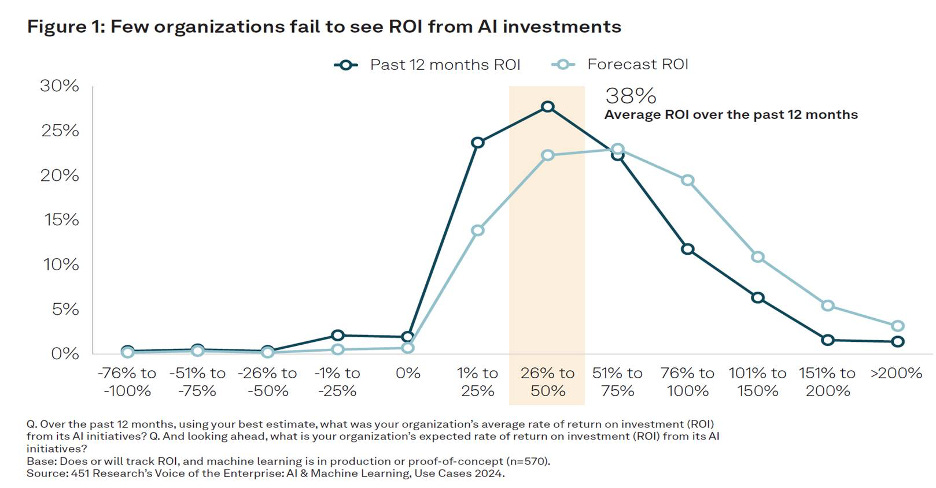The integration of Artificial Intelligence (AI) into the workforce marks a transformational shift in how businesses operate. Similar patterns are emerging to earlier technological adoptions, usch as huge spending before tangible results. Nevertheless, the promise of AI is there, from automating routine tasks to providing sophisticated data insights, AI technologies are heralded for their potential to enhance efficiency across various sectors. However, this innovation comes with an environmental cost—an alarming rise in energy consumption. Wells Fargo's projection reveals a stark reality: AI power demand is poised to surge by an astounding 8,050% from 2024 to 2030. As the tech companies themselves start to scale back their net-zero initiatives, other organizations can pick up the slack by themselves managing their AI to net-zero, even today.
Efficiency Gains through AI
AI is revolutionizing the workplace by driving remarkable efficiency improvements. These technologies are capable of handling tasks that are repetitive, data-intensive, and require precision, thus freeing up human workers for more strategic and creative responsibilities. In addition, “co-pilots” are making people’s jobs easier, from programmers to call center employees. Industries ranging from finance to healthcare are leveraging AI for tasks such as:
1. Helping Financial Advisors: Advisors are seeing gains from note-taking agents that can connect into the rest of their applications, like their client relationship management system.
2. Enhancing Customer Service: Chatbots and AI-driven customer service platforms can handle vast numbers of inquiries simultaneously, providing instant responses and freeing up human agents to tackle more complex issues.
3. Creating Content: LLMs can create content, like advertising and social media posts. With a little direction to the AI, writers can save a fair amount of time.
While these applications underscore the transformative power of AI, the significant increase in power consumption remains an ecological challenge.
The Environmental Impact of AI
AI's energy consumption is projected to increase dramatically in the coming years. According to data from Wells Fargo, AI power demand will jump from 8 TWh in 2024 to 52 TWh by 2026, and then skyrocket to 652 TWh by 2030 . This increase represents more than 16% of the current total electricity demand in the United States, driven predominantly by the energy-intensive nature of AI training and inference processes.
AI Training: The process of training AI models on large datasets is particularly energy-intensive, requiring substantial computational power to develop and refine algorithms. Training demand alone is expected to consume 40 TWh by 2026 and 402 TWh by 2030.
AI Inference: Following the training phase, AI models deployed for inference—real-time decision-making and predictions—will further escalate energy requirements. The efficiency gains from AI are thus shadowed by the looming environmental cost if current practices continue unabated. Note that Wells Fargo may be overestimating inference numbers as some AI computing moves to the edge – like your phone.
Pathways to Sustainable AI
To mitigate the environmental impact while reaping the benefits of AI, we must adopt strategic measures aimed at sustainable implementations. Achieving net-zero AI is not only feasible but imperative, involving both immediate actions and long-term strategies.
1. Purchasing Carbon Credits/Offsets: In the short term, companies can invest in carbon credits and offsets. These credits support projects that reduce greenhouse gas emissions elsewhere, effectively balancing out the emissions generated by AI operations.
2. Renewable Energy-Powered Data Centers: Over the long term, businesses must focus on locating data centers near renewable energy sources. Data centers are the backbone of AI operations, and sourcing their energy from wind, solar, hydroelectric, or nuclear power can significantly reduce carbon footprints. Batteries required to reach 100% renewable.
3. Developing Energy-Efficient Algorithms: Research into and development of more energy-efficient algorithms, from both the data center and power grid sides, can also curb AI’s energy appetite. Innovations in this space can lead to reduced power requirements without compromising performance.
A Call to Action
The burgeoning power demands of AI necessitate a concerted effort from businesses and society at large to forge a path toward sustainable usage. Addressing the environmental impacts of AI is not just a corporate responsibility; it is crucial for the wellbeing of the planet. Leading companies already recognize that sustainable practices are integral to their long-term success and societal license to operate.
By committing to net-zero AI, investing in renewable energy, and exploring innovative energy-saving technologies, the tech industry can lead the charge in marrying efficiency with environmental stewardship. This holistic approach is vital not just for businesses but for society as a whole, ensuring that the benefits of AI are realized without compromising the health of our planet.
AIR-GPT was used in the production and editing of this article.
Copyright © 2024 by Artificial Intelligence Risk, Inc. This article may not be redistributed in whole or part without express written permission from the author.





